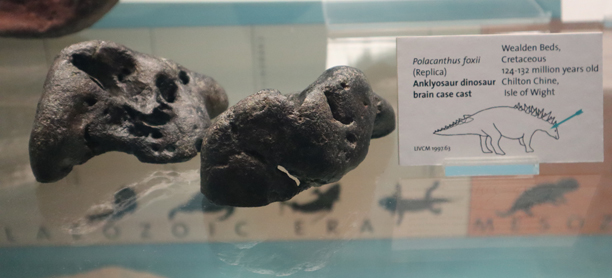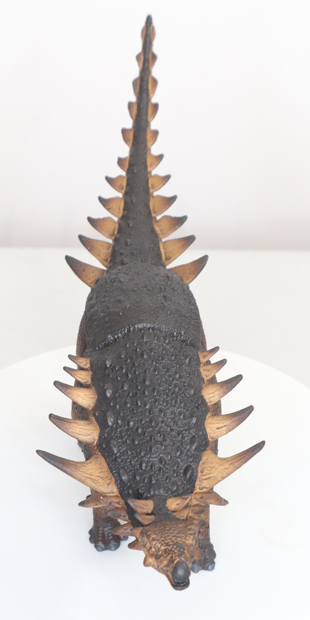In the Liverpool World Museum there are several exhibits that feature dinosaur fossils. One display case includes two, worn fossils which are described as Polacanthus foxii fossil material. The fossil material has a rounded appearance. According to the display label these fossils are from the Wealden Beds exposed at Chilton Chine on the Isle of Wight. They are described as casts (copies) of a Polacanthus braincase. The actual fossils probably came out of the cliffs and were exposed on the beach for some time prior to their discovery. These fossils were rolled around the beach and attrition caused their rounded and weathered appearance.
However, these fossils, or their copies may not represent Polacanthus foxii.

Picture credit: Everything Dinosaur
Labelling Polacanthus Fossils
The Wealden Group covers several million years of deposition. To date, armoured dinosaurs named and scientifically described from the Wealden Group include Hylaeosaurus, the recently named Vectipelta and Polacanthus.
To read Everything Dinosaur’s blog post on Vectipelta: Vectipelta barretti Honours Natural History Museum Professor.
The fossils, although labelled as Polacanthus, may not represent that taxon. Fossils from the Isle of Wight attributed to Polacanthus may actually represent multiple, as yet unnamed taxa.
Picture credit: Everything Dinosaur
The picture (above) shows the new for 2024 CollectA Deluxe Polacanthus model. This figure is based on the Polacanthus foxii holotype material. It is a modern interpretation of the known fossil material.
To view the CollectA Deluxe range of figures: CollectA Deluxe Prehistoric Animal Figures.
Vectipelta for example, is only distantly related to both Hylaeosaurus and Polacanthus foxii.
It is unlikely that all the fossil material ascribed to the Polacanthus taxon displayed in museums actually represents P. foxii, or indeed any other possible species as yet unassigned to the Polacanthus genus.
The Everything Dinosaur website: The Everything Dinosaur website.







Leave A Comment